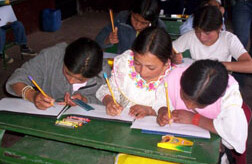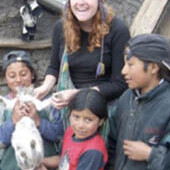After teaching elementary school for ten weeks in a small village in rural Ecuador, I came away from the experience with a lot more than the standard shock at the poverty and conditions in the developing world. Instead, I was surprised by how little is really needed to change those conditions.
For most of us wanting to pursue public service, our optimism is routinely lanced by those who believe we can't make a difference. Yet my students learned simple arithmetic and their once dilapidated school was repainted, with windows replaced and supplies replenished for a cost of less than 100 dollars. These were small changes, but they mattered.
The children we worked with were up against more than just shabby schools. In Ecuador, as in many developing countries, public education costs money. Between books, matriculation fees, uniforms, and supplies, each child must pay at least 200 dollars a year—an impossible amount for families living on two dollars a day.
Oftentimes, nobody in a village can afford to continue school beyond basic levels. Other times, a family will pool its resources and send one child out of five, devastating the others. When these select few enter school, they are vastly unprepared. They come from classrooms of 30 children of differing ages led by one teacher—often a teacher in training who hopes to be moved to a school in the city upon completing her certification.
The Village Education Project was created to eliminate these barriers. The organization began with a conversation between me and my Ecuadorian host father, a primary school principal. We were joined by a fellow volunteer and a lawyer from Quito. We designed the program collaboratively, with each person assigned a role in the organization. The volunteer and I raise funds and coordinate the volunteer aspect, while the Ecuadorian principal manages daily operations and the lawyer handles our nonprofit status and documentation. Our plan is simple: We want each child to be able to attend high school, regardless of financial circumstances.
To implement our plan, we started in four villages surrounding the city of Otavalo. We decided to build our program based on villages rather than individual children in order to simulate a normal public school environment, where all children in a neighborhood are sent to the same schools so that they can help each other adapt and grow. We also thought that situating ourselves in villages would allow us to better prepare the students as they entered high school.
The first element of our program is to sponsor any student from the four selected villages who wishes to attend high school. This year, that number totaled 48 matriculating students. Second, we prepare the students with summer courses in mathematics and English, subjects in which the students are typically lacking. Working in accordance with Ecuadorian standards for secondary education, we train volunteers to teach summer classes in the village schools.
We were concerned about the potential popularity of intense summer classes. We planned to have a test every week to chart student progress, and to keep strict attendance records. The day before classes began, one of the volunteers traveled to the villages with the Ecuadorian principal to announce classes with a megaphone. She described how parents rushed the car for more information, how the children ran behind. The results were exhilarating—and ultimately exhausting. Not only did we find the 48 eligible children waiting for us at the first class, but more than 100 younger children also came to learn. We did our best to navigate the various levels of education in our classrooms, sharing teaching tactics nightly.
The students were not the only ones with a rigorous program. Our volunteers worked around the clock. Some rose early for Spanish lessons or to prepare for afternoon classes. But motivation was strong because the stakes were high. When volunteering has such tangible results—a student's success or failure in her shot for a better life—a new teacher suddenly acquires a lot of responsibility and inspiration.
The third component of our program is to supplement our teaching with material resources from the developed world. We held an ambitious school supplies drive with St. Gabriel's Elementary School in Charlotte, North Carolina. From the supplies collected, we gave each child a notebook, crayons, markers, erasers, and an English vocabulary book. Meanwhile, we built a teacher resource center at the Otavalo hostel in which the volunteers were staying. This year, we hope to bring computers for the children so that every village school where we operate will have access.
Our work is simple, but I have come to believe that it represents a promising trend in development. Many development initiatives fail because they try to impose new structures on societies, ignoring community nuances.
Our work focuses not on creating new opportunities, but on eliminating the barriers to opportunities that exist already in Ecuador. Using the villages, schools, and curricula that are already in place, we create a new fluidity and class mobility.
If we can demonstrate the potential for change when barriers are eliminated, we can spur government action by providing an example of positive change. We are only in the beginning phases, but it is my dream that The Village Education Project will become a template for poverty alleviation beyond our four villages, in villages worldwide.
To learn more about The Village Education Project or to volunteer with them in Summer 2007, please visit www.villageeducation.org or write to [email protected].




